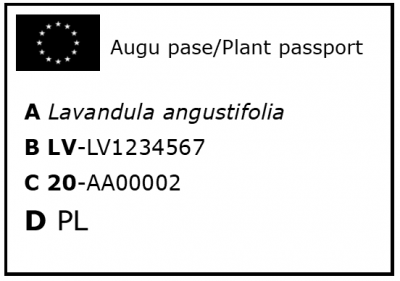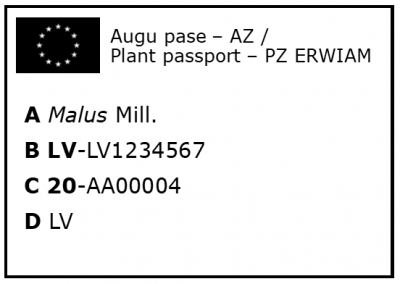All plants intended for planting (including potted plants) must have plant passports to ensure the marketing of healthy and high quality planting stock in the European Union (EU).
What is a plant passport?
A plant passport is a document (in the form of a label) certifying that the plants have been grown in a nursery that has:
- registered with a national plant protection organisation (in Latvia, the State Plant Protection Service),
- tested the plants to ensure that they are free from European Union quarantine organisms, protected zone quarantine organisms (hereinafter referred to as 'plant quarantine organisms') and regulated non-quarantine organisms the occurrence of which significantly reduces the quality of the planting stock.
Why is the plant passport needed?
As plants can be moved and traded freely throughout the EU (except in protected zones, which have additional conditions), if plants show signs of harmful organisms, the information in the plant passport can be used to trace the origin of the plant. This is necessary to detect plant quarantine organisms as soon as possible and to limit their further spread. Plant passports or the information contained therein should therefore be kept for at least three years.
How does the plant passport look like?
The plant passport has a common format in all EU countries (rectangular or square shape) and contains specific information:

The EU flag in the top left corner, which can be in color or black and white, with white stars on a black background or vice versa.
In the top right corner, the words 'Plant Passport' in one of the EU national languages and in English, separated by a slash.
Letter designation:
A – botanical name of the plant species
B – the country where the plant passport was issued and the registration number in the Official Register of Professional Operators
C - traceability code (batch number)
D – country of origin of the plant
Is a plant passport always necessary?
Plant passports are required for commercial operations - "business-to-business" - i.e. when plants are sold for resale or grown commercially. A plant passport is required if the plants are purchased by a shop that will resell them, or if they are purchased by a landscaping company for planting.
A plant passport is not required if the plants are sold directly to the end user (if the market or shop will sell the plants to those who will grow them for their own use only, plant passport is not required) - this does not apply to fire blight host plants (see 'Protected zones' below).
Does a plant passport have to be attached to Do fire blight host plants need to have a plant passport in every case?Do fire blight host plants need to have a plant passport in every case?plant?
The plant passport must be attached to the smallest marketing unit - it may not be attached to every plant (exceptions are host plants for fire blight (see information on 'Protected zones')).
What is a protected zone?
A protected zone is an area in the EU (an EU country or a part of it) where a particular harmful organism is not found. In this area, targeted inspections are carried out and additional requirements for the importation of plants are imposed to ensure that the harmful organism is not introduced into the area.
Latvia has been granted the status of protected zone in respect of fire blight (Erwinia amylovora).
Can fire blight host plants be imported from all EU countries?
Fire blight host plants may only be imported to Latvia from:
- other fire protected zones: Estonia, Spain (except certain autonomous regions and provinces), France (Corsica), Finland, certain parts of Italy, Ireland (except Galway), Lithuania (except Babtai and Kedainiai municipalities (Kaunas region)), Slovenia (except certain regions and communes) and from Slovakia (except certain parishes).
- officially recognised buffer zones in EU countries where fire blight is present.
Fire blight host plants produced in Latvia can be distributed without restrictions in EU countries, including Lithuania, Finland and Estonia, which are also protected zones.
Why is fire blight dangerous?
Fire blight reduces fruit yield and is also very dangerous for the plants themselves. In the most susceptible host plants, the infection spreads so rapidly that the plants quickly die soon after the first signs of infection appear.
Fire blight of host plants:
- Shadbushes Amelanchier
- Cotoneasters Cotoneaster
- Hawthorns Crataegus
- Quinces Cydonia
- Eriobotrya Eriobotrya
- Apple trees Malus
- Medlars Mespilus
- Firethorns Pyracantha
- Pear trees Pyrus
- Rowans Sorbus
- Flowering quinces Chaenomeles
If the presence of fire blight is suspected, please report it to the State plant protection service's inspectors!
What kind of plant passports are attached to plants in protected zones?

TWhen host plants of fire blight are traded in Latvia, they must have plant passports specifically for protected zones. These must bear the protected zone designation and the scientific name of the protected zone organism or its code next to the words 'Plant passport' e.g. 'Augu pase - AZ / Plant passport - PZ ERWIAM' or 'Augu pase - AZ / Plant passport - PZ Erwinia amylovora' .
These plant passports certify that the plants have been laboratory tested and are free from the specified organism of the protected zone.
Does every fire blight host plant has to have a plant passport attached?
When marketing host plants of fire blight, a plant passport bearing the indication 'PZ' and the scientific name or code ERWIAM of the fire blight should be attached to each plant (or bundle of plants if the plants are bundled).
Do fire blight host plants need to have a plant passport in every case?
Even if the plants are intended and sold directly to the end user (at a market or at a store), the plant passport must be attached to the plant.
When buying plants, care should be taken to ensure that they are accompanied by the appropriate plant passport. It is important to remember that plant quarantine organisms are very destructive and one diseased seedling can cause the death of many plants in your garden and in your neighbourhood.
For more specific information on protected zones and specific requirements, please contact the Plant Quarantine Department of the State Plant Portection Service.



